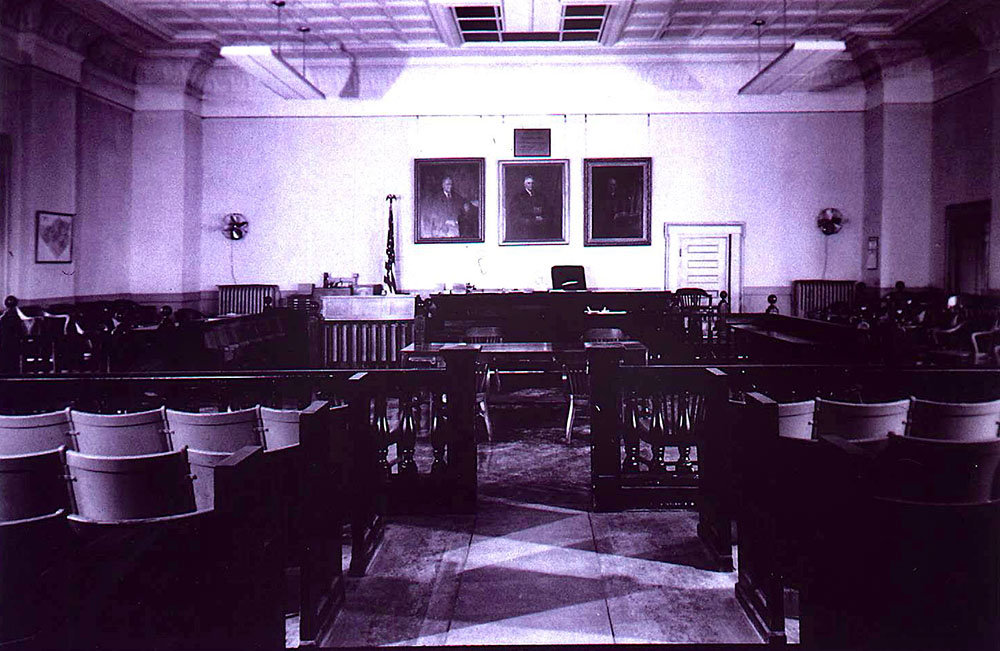
Courtroom of old Newburgh Courthouse, 1950 view before demolition.
By Mary McTamaney
This is the last week of school for the 2021-22 year and students at every grade level are showcasing their accomplishments and using some time between tests to enjoy enrichment activities. Art, dance and music students have presented events that show their talents, moving-up days have celebrated younger children for their accomplishments and awards ceremonies have sent NFA students off with medals, citations and scholarships.
NFA is one of New York State’s oldest academies, founded in 1796. It occupied a classical white frame schoolhouse on Montgomery Street (the site of today’s Horizons-On-Hudson Elementary). Although impressive for its time, the original academy was not spacious. It was two floors of classrooms, arranged in a standard square layout just like a large house. One upstairs room also served as the meeting place for the village council and for the village court.
As the student population grew along with Newburgh’s growth, and especially when the school became tuition-free in 1852 when New York passed legislation for free public education, the activities of all schools, particularly the academy, needed to find extra venues. The courtroom of the county courthouse on Grand Street provided program space after court sessions had ended for the day. Thus, many civic events in the early 19th century were held there. One interesting event came to light in the twentieth century when a man showed a local newspaper reporter a treasure he had discovered among family papers. He had a finely printed program for “The Night with Young Ideas” in the spring of 1856. Sadly, the old printed program vanished again with time but the newspaper did a good job of reporting the event it described.
In the old Grand Street courthouse (where the courtroom was upstairs on the second floor), sixty-five Newburgh Free Academy seniors gathered before an audience of parents and friends and each presented a recitation or song or dramatic reading. The entire list was reprinted from the original paper program in that 1920’s newspaper. A boy named Francis Wells began the evening with an opening oration he had composed in Latin. James Lally read an essay he wrote on “Our Government.” Mary Johnston read her essay, “The Beauties of Nature.”
Charles Brown read “The Murderer’s Secret” by Daniel Webster and John Little (who went on to be one of Newburgh’s master builders) delivered his essay, “The Structure of the Universe.” Anna Weston reminded her classmates “All Is Not Gold That Glitters” and Frank Ried read Hamlet’s Advice to the Players. There were several songs performed by single students and small groups and two that were delivered by the entire class including a song titled “The Better Land.” The Civil War was on the horizon and 18 year-olds would have been aware of change coming.
Grand Street was full of noise and hope that spring evening in 1856. After Martha Brown lectured on “The Web of Life,” the program began to wind toward its finale, a mass singing of the “Evening Parting Hymn” and then a benediction. Students walked down the stairs and out into the courthouse park where they could see boat lights twinkle on the Hudson River. It must have been nearly midnight because a showcase of 65 presentations would take that long.
Where did those 65 seniors travel after graduation? It would be a worthy exercise to track them through the census and find out. The 1920’s Newburgh News Reporter recognized some of the names and provided a few windows to the future. Those graduates went on, he wrote, to be retailers and restauranteurs and even one, William Brown, the warden of Sing Sing Prison. The young women didn’t achieve the same recognition even by the 1920’s. The news reporter simply said that “a number of the young women married prominent Newburgh citizens, while a few remained in the profession they prepared to fill and were employed by the Board of Education as teachers in the public schools.” No wonder young Annie Connolly had composed a poem “To The Flowers of the Forest,” her sanctuary.